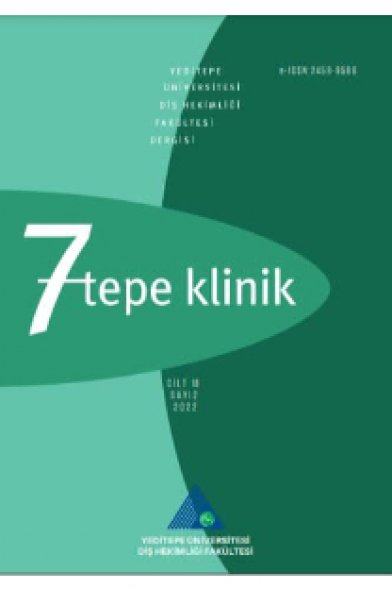Alt çene ön bölge çapraşıklığa sahip olgularda iki farklı braket sisteminin kısa dönem etkilerinin değerlendirilmesi
An assessment of short-term effects of two different bracket systems in mandibular anterior crowding
___
- 1. Turnbull NR, Birnie DJ. Treatment efficiency of conventional vs self-ligating brackets: effects of archwire size and material. American Journal of Orthodontics and Dentofacial Orthopedics 2007; 131: 395-399.
- 2. Eberting JJ, Straja SR, Tuncay OC. Treatment time, outcome, and patient satisfaction comparisons of Damon and conventional brackets. Clinical orthodontics and research 2001; 4: 228-234.
- 3. Badawi M, Toogood RW, Carey JP, Heo G, Major PW. Torque expression of self-ligating brackets. American Journal of Orthodontics and Dentofacial Orthopedics 2008; 133: 721-728.
- 4. Morina E, Eliades T, Pandis N, Jager A, Bourauel C. Torque expression of self-ligating brackets compared with conventional metallic, ceramic, and plastic brackets. The European Journal of Orthodontics 2008; 30:233-238.
- 5. Montasser MA, El-Bialy T, Keilig L, Reimann S, Jäger A. Force levels in complex tooth alignment with conventional and self-ligating brackets. American Journal of Orthodontics and Dentofacial Orthopedics 2013; 143: 507-514.
- 6. Montasser MA, Keilig L, Bourauel C. An in vitro study into the efficacy of complex tooth alignment with conventional and self‐ligating brackets. Orthodontics & Craniofacial Research 2015; 18: 33-42.
- 7. Atik E, Ciğer S. An assessment of conventional and self-ligating brackets in Class I maxillary constriction patients. Angle Orthodontist 2014; 84: 615-622.
- 8. Pandis N, Polychronopoulou A, Eliades T. Self-ligating vs conventional brackets in the treatment of mandibular crowding: a prospective clinical trial of treatment duration and dental effects. American Journal of Orthodontics and Dentofacial Orthopedics 2007; 132: 208-215.
- 9. Pandis N, Polychronopoulou A, Makou M, Eliades T. Mandibular dental arch changes associated with treatment of crowding using self-ligating and conventional brackets. The European Journal of Orthodontics 2009; 32: 248-253.
- 10. Fleming PS, DiBiase AT, Sarri G, Lee RT. Comparison of mandibular arch changes during alignment and leveling with 2 preadjusted edgewise appliances. American Journal of Orthodontics and Dentofacial Orthopedics 2009; 136: 340-347.
- 11. Jones M, Chan C. The pain and discomfort experienced during orthodntic treatment: A randomized controlled clinical trial of two intial aligning arch wires. American Journal of Orthodontics and Dentofacial Orthopedics 1992; 102: 373-381.
- 12. Polat O, Karaman AI. Pain control during fixed orthodontic appliance therapy. The Angle Orthodontist 2005; 75: 214-219.
- 13. Abdelrahman, RSh, Al-Nimri KS, Al Maaitah EF. Pain experience during initial alignment with three types of nickel-titanium archwires: a prospective clinical trial. The Angle Orthodontist 2015; 85: 1021-1026.
- 14. Otasevic M, Naini FB, Gill DS, Lee RT. Prospective randomized clinical trial comparing the effects of a masticatory bite wafer and avoidance of hard food on pain asso ciated with initial orthodontic tooth movement. American Journal of Orthodontics and Dentofacial Orthopedics 2006; 130: 6-9.
- 15. Miles PG, Weyant RJ, Rustveld L. A clinical trial of Damon 2™ vs conventional twin brackets during initial alignment. The Angle Orthodontist 2006; 76: 480-485.
- 16. Fleming PS, Dibiase AT, Sarri G, Lee RT. Pain experience during initial alignment with a self-ligating and a conventional fixed orthodontic appliance system: a randomized controlled clinical trial. The Angle Orthodontist 2009; 79: 46-50.
- 17. Scott P, Sherriff M, Dibiase AT, Cobourne MT. Perception of discomfort during initial orthodontic tooth alignment using a self-ligating or conventional bracket system: a randomized clinical trial. The European Journal of Orthodontics 2008; 30: 227-232.
- 18. Storey E. Force in orthodontics and its relation to tooth movement. Aust J Orthod 1952; 56: 11-18.
- 19. Quinn RS, Yoshikawa DK. A reassessment of force magnitude in orthodontics. American Journal of Orthodontics 1985; 88: 252-260.
- 20. Oppenheim A. A possibility for physiologic orthodontic movement. American Journal of Orthodontics and Oral Surgery 1944; 30: 345-368.
- 21. Nikolai RJ. On optimum orthodontic force theory as applied to canine retraction. American Journal of Orthodontics 1975; 68: 290-302.
- 22. Hixon EH, Atikian H, Callow GE, McDonald HW, Tacy RJ. Optimal force, differential force, and anchorage. American Journal of Orthodontics 1969; 55: 437-457.
- 23. Reitan K. Effects of force magnitude and direction of tooth movement on different alveolar bone types. The Angle Orthodontist 1964; 34: 244-255.
- 24. Schwarz AM. Tissue changes incidental to orthodontic tooth movement. International Journal of Orthodontia, Oral Surgery and Radiography 1932; 18: 331-352.
- 25. Oppenheim A. Human tissue response to orthodontic intervention of short and long duration. American Journal of Orthodontics and Oral Surgery 1942; 28: 263-301.
- 26. Reitan K. Clinical and histologic observations on tooth movement during and after orthodontic treatment. American Journal of Orthodontics 1967; 53: 721-745.
- 27. Parvizi F, Rock WP. The load/deflection characteristics of thermally activated orthodontic archwires. The European Journal of Orthodontics 2003; 25: 417-421.
- 28. Shivapuja PK, Berger J. A comparative study of conventional ligation and self-ligation bracket systems. American Journal of Orthodontics and Dentofacial Orthopedics 1994; 106: 472-480.
- 29. Berger J, Byloff FK. The clinical efficiency of self-ligated brackets. Journal of Clinical Orthodontics 2001; 35: 304-310.
- ISSN: 2458-9586
- Yayın Aralığı: 3
- Başlangıç: 2005
- Yayıncı: Yeditepe Üniversitesi Rektörlüğü
KIBT’nin (Konik Işınlı Bilgisayarlı Tomografi) endodontide kullanımı:Durum güncellemesi
Cemre KOÇ, FUNDA YILMAZ, Kıvanç KAMBUROĞLU
Dev Wharton kanalı taşının ağız içi yaklaşımla tedavisi: Bir olgu sunumu
CANSU GÖRÜRGÖZ, Murad OSMANLI, MEHMET HAKAN KURT, Orkhan İSMAYILOV, HAKAN ALPAY KARASU
Diş hekimliği uygulamalarında topikal steroidler: Yan etkileri ve kullanım önerileri
Tekrarlanan fırınlamaların zirkonyanın bükülme dayanımı üzerine etkisi
Siyah çay tüketim sıklığının ağız ve diş sağlığına etkisi
Aşırı harabiyet gösteren endodontik tedavili dişlerin protetik restorasyonları
Ghyeath Munadhil AZEEZ, IŞIL ÇEKİÇ NAGAŞ
ZELİHA UĞUR AYDIN, KEREM ENGİN AKPINAR, CEYLAN HEPOKUR, Merve ALPAY, DEMET ALTUNBAŞ
ŞİRİN GÜNER ONUR, Batın Ilgıt SEZGİN, CEM TOKATLI, EDA HAZNEDAROĞLU, Alev Eda OKUTAN, Gökçe Çiçek İLDEŞ, ELİF ECE KALAOĞLU, Belgin YAZICI, ALİ RECAİ MENTEŞ
Karıştırma ve yerleştirme teknikleri Mineral Trioksit Agregatının pH değerini etkiler mi?
Dilek TÜRKAYDIN, Paul DUMMER, Mohammad Hossein NEKOOFAR, Fatima Betül BAŞTÜRK, Mahir GÜNDAY
